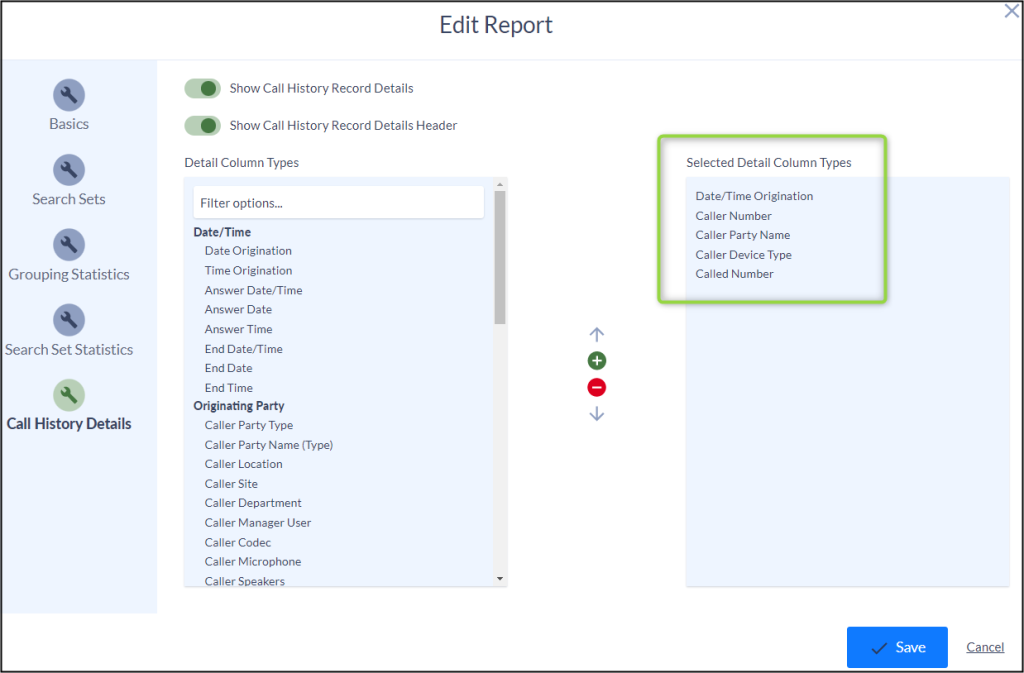Introduction
Variphy’s Call Analytics Reporting for Zoom Phone isn’t based on anything “Canned” that arrives out of the box. Because every environment can be a bit different, Variphy’s Call Analytics Reporting is completely customizable, allowing reports to be configured for particular dial plans and deployments, along with the desired output content.
Because different user audiences require different data, reports generated by Variphy’s Call Analytics Reporting can be tailored to produce simple/high level information such as Summary metrics only or very granular detail showing CallerID, Extensions, Users, Devices and more.
Basic Report Concepts
Each Variphy Call Analytics Report configuration is based upon what Call Data is being Searched (the “Input”) and what resulting content is computed and displayed (the “Output”).
A Report configuration is not tied to a particular Search Time Window or Document Output Format (PDF, XLSX, HTML, CSV). This means that the same Variphy Call Analytics Report can be used to create reports for different Document Output Formats and/or different periods of time.
When generating a reports in Variphy, the Search Time Window (such as “Yesterday” or “May 1 – May 4, 2022”) and Document Output Format is also chosen, which together are all used to produce the desired output.
Summary, Statistics, and Detail Content (“Output”)
All of the possible content that a report contains is based upon the Search Set and can be enabled (and configured) or disabled according to the type of report you’re looking to generate.
Variphy’s Call Analytics History Report content output is comprised of the following possible sections. If all are enabled/applicable, they will appear in this order in the report output:

Application System Logo

Variphy comes bundled with a default system logo, which is the Variphy Logo.
It can be replaced/updated by Variphy Administrators via the Logos option in the Setup menu at the top right corner of the Variphy Web Interface.

The Application System logo will be shown in the upper right of every page in the report for image supported document types (PDF).
With the aspect ratio preserved, the width of the System Logo in the report will be decreased to 120 pixels automatically.
Zoom Account Logo

If configured, the corresponding Logo for the corresponding Platform will be included in the upper left of the report for image supported document types (PDF). Platform Logos can be specified/updated by Variphy Administrators via the Logos option in the Setup menu at the top right corner of the Variphy Web Interface.

With the aspect ratio preserved, the width of the Cluster Logo in the report will be decreased to 120 pixels automatically.
Basics
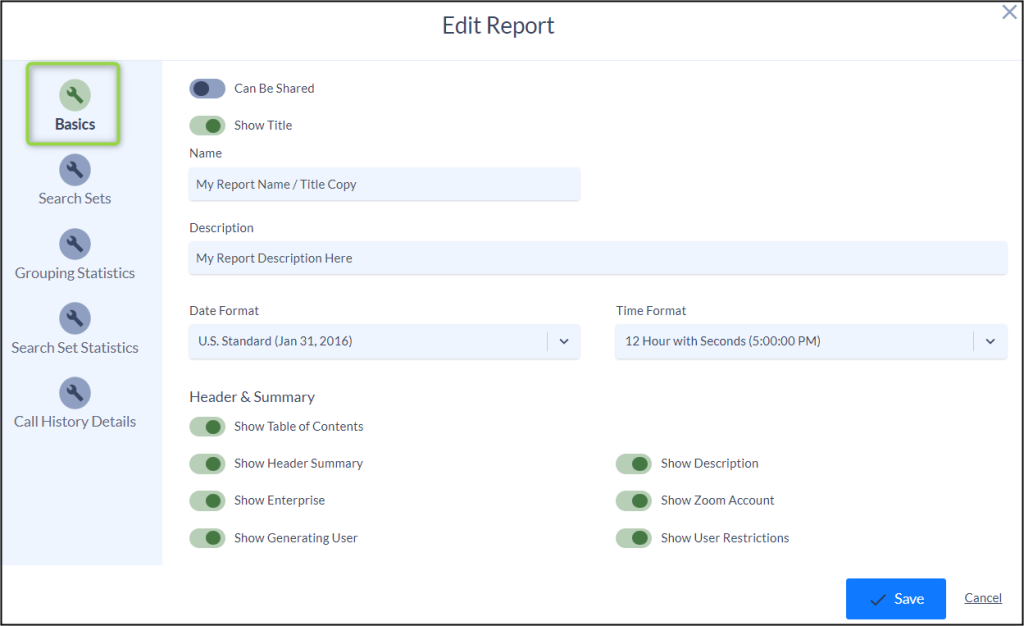
Report Title
The report’s name (as configured in Variphy) will be used for the title in the output. The name can be configured in Variphy when adding or editing any report and can contain up to 255 characters.

The report name/title can be updated in the Name field in the Basics tab.
To exclude the title from a report, simply uncheck the Show Title option in a report’s configuration.
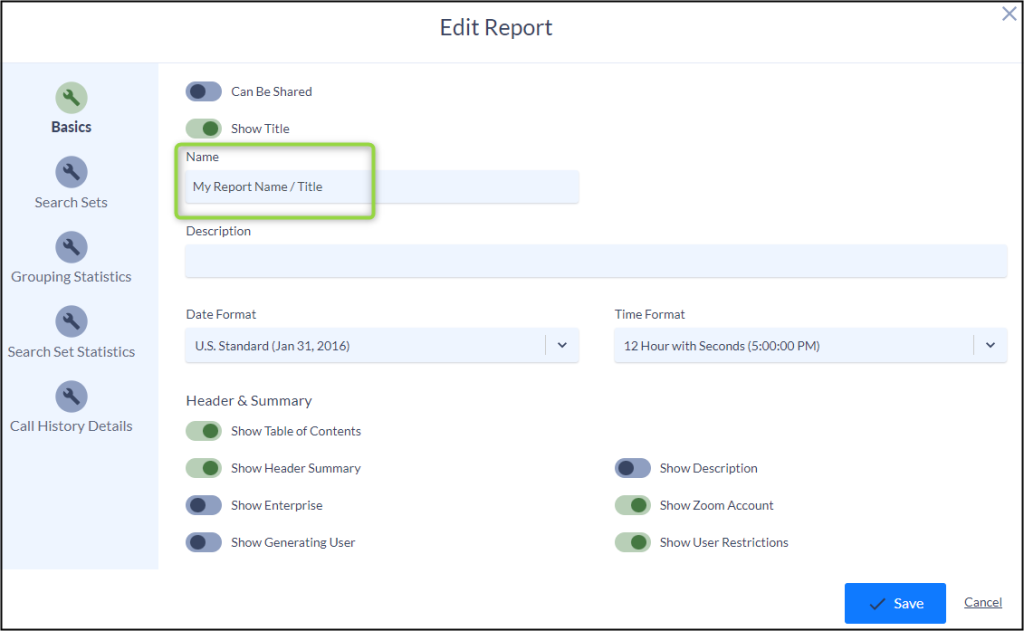
Date Format & Time Format
Choose the preferred Date and/or Time Format, ranging from popular U.S. and international options.
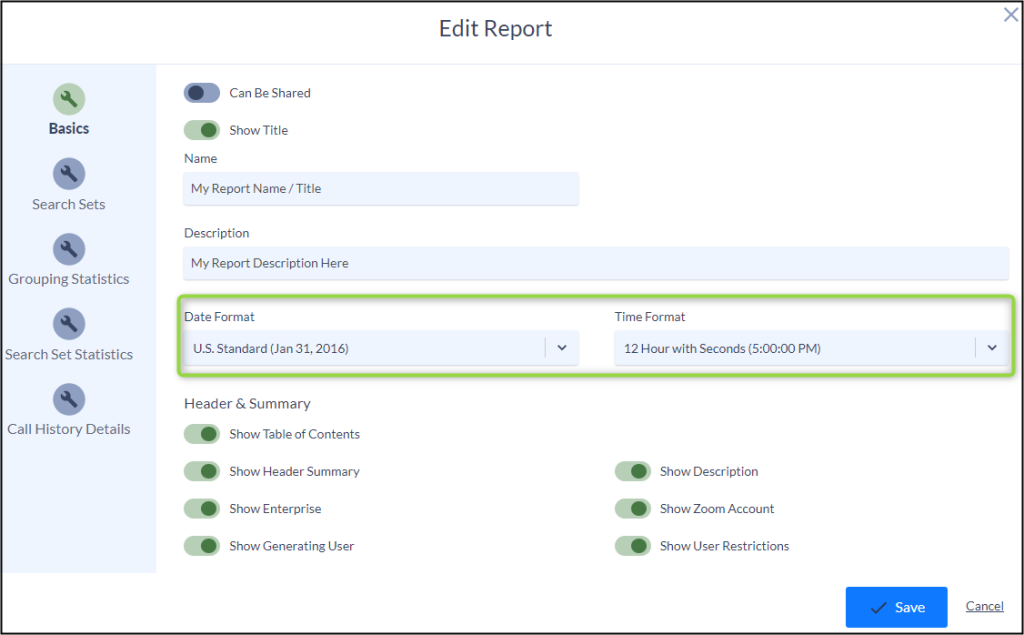
Header & Summary

If enabled, the Summary in a report’s output can contain any/all of the following. The entire Summary can be enabled or disabled by toggling the Show Header Summary option.
- Description – The description as configured for the report, which can contain up to 500 characters. To enable or disable this from the Summary, toggle the Show Description option.
- Date/Time Range – The Date/Time Window for which the report was generated for. If the Show Header Summary field is enabled, this will be shown automatically.
- Enterprise – The name of the Enterprise, as configured in Variphy, to which the Cluster (which the report was generated for) is assigned to. To enable or disable this from the Summary, toggle the Show Enterprise option.
- Cluster – The name of the Cluster in Variphy which the report was generated for. To enable or disable this from the Summary, toggle the Show Cluster option.
- Generated By – The username of the User which generated the report in Variphy. To enable or disable this from the Summary, toggle the Show Generating User option.
- User Restrictions – This will display if the report was generated by a user with data visibility restrictions (where the user is not configured with the ability to see all CDR data for the Cluster), by showing “(Limited)” next to the Cluster name. To enable or disable this from the Summary, toggle the Show User Restrictions option.
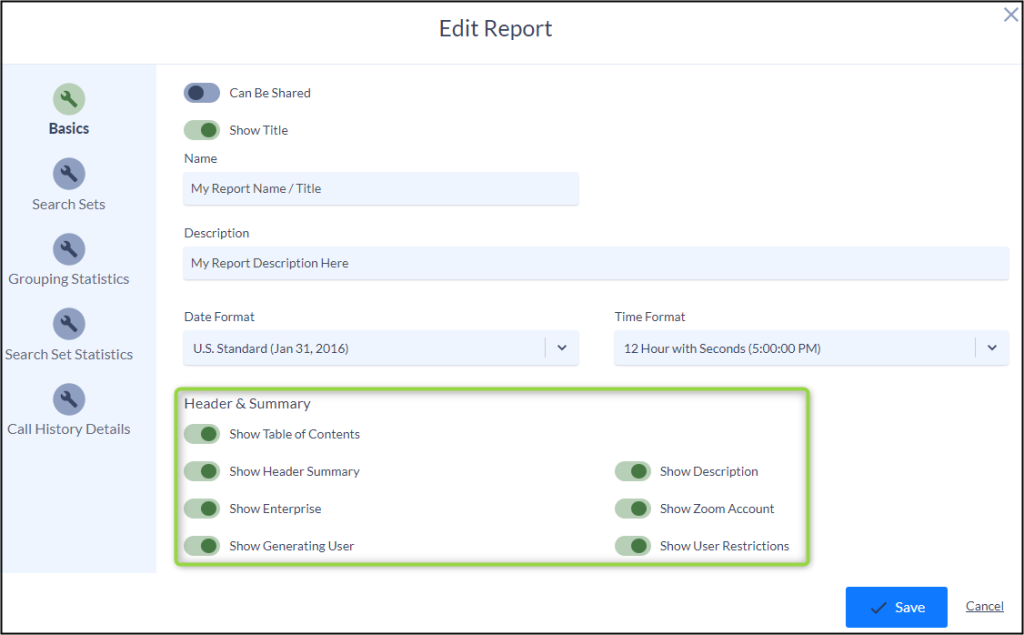
Table of Contents
The Table of Contents section contains content hyperlinks to navigate to a particular section in the report.

To enable or disable the Table of Contents from appearing in the report, toggle the Show Table of Contents option in the Header & Summary section on the Basics tab.

Search Sets (“Input”)
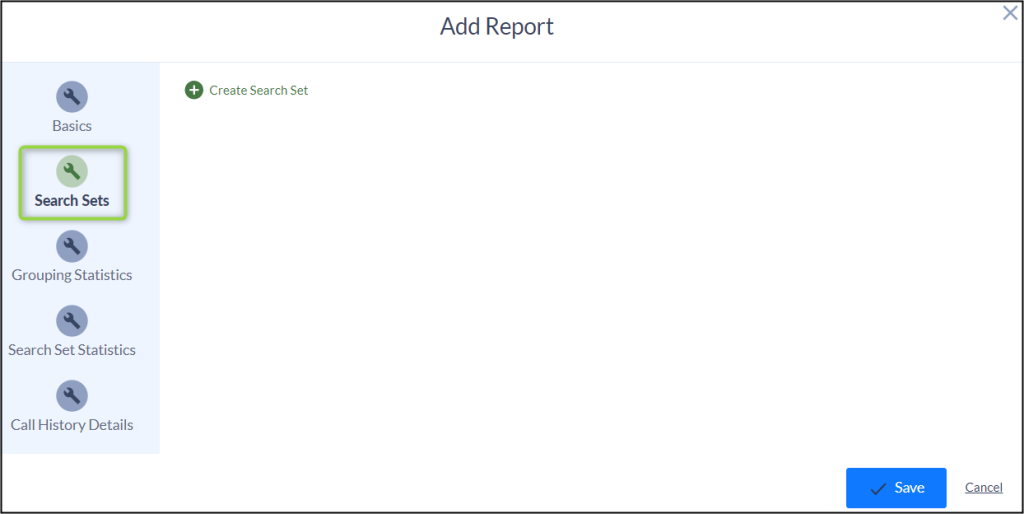
Each report is based on a “Search Set” that identifies the desired call activity, such as:
- All calls to 911
- To or from all end users in the Operations Department
- To the Helpdesk Call Queue
- Originating or terminating from users Dan or Abbey
Each report must contain at least 1 Search Set, which in turn, must contain at least 1 Search Criteria. A single Search Set (with 1 or multiple Criteria) is often all that is needed, but in some cases, multiple Search Sets may be required to pinpoint a very specific set of call activity.
The Search Sets tab contains the report’s configuration for Search Set Criteria. For each of the examples above , the Search Sets might look like:
- All calls to 911
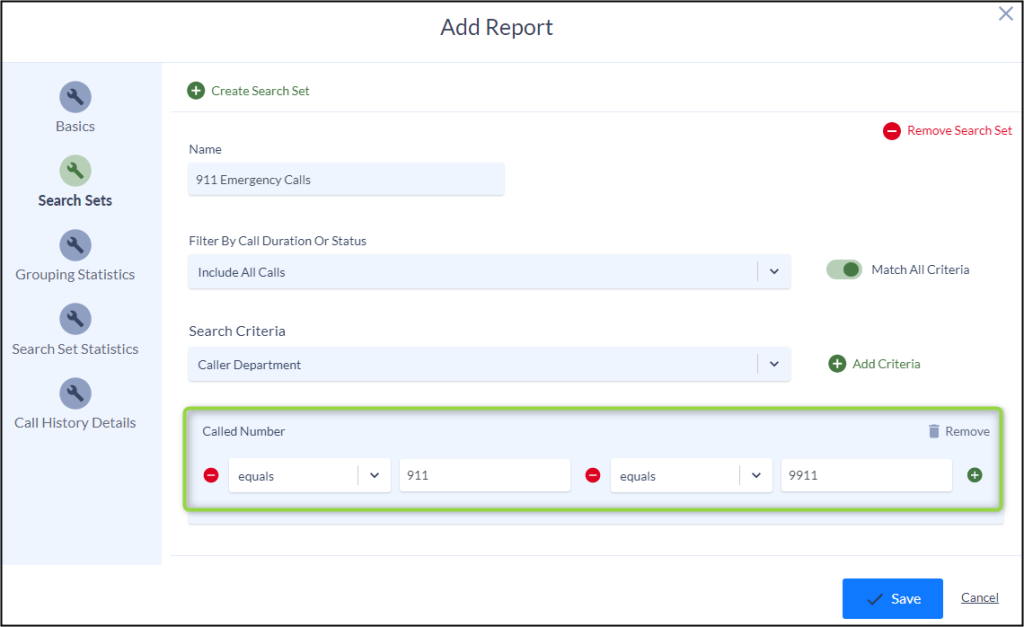
- To or from all users in the Operations department
- User based Search sets such as Caller/Called User or Caller/Called Department allow for querying of historic user information. Toggling on the “Show Historical Options” allows you to search on user based information no long existing in your Zoom hierarchy. For example: If a user is no longer with the company but you wish to search his name explicitly, you can toggle on “Show Historical Options” and select the user from the picklist. Historical entities will appear with a small flag next to their respective criteria indicating it is a historical entity.
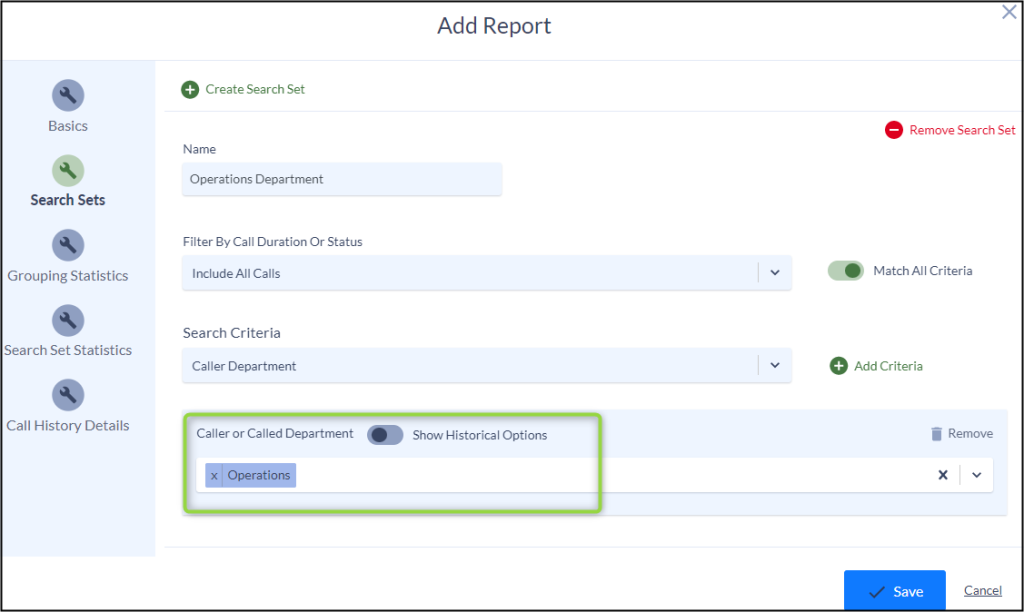
- To the Helpdesk call queue
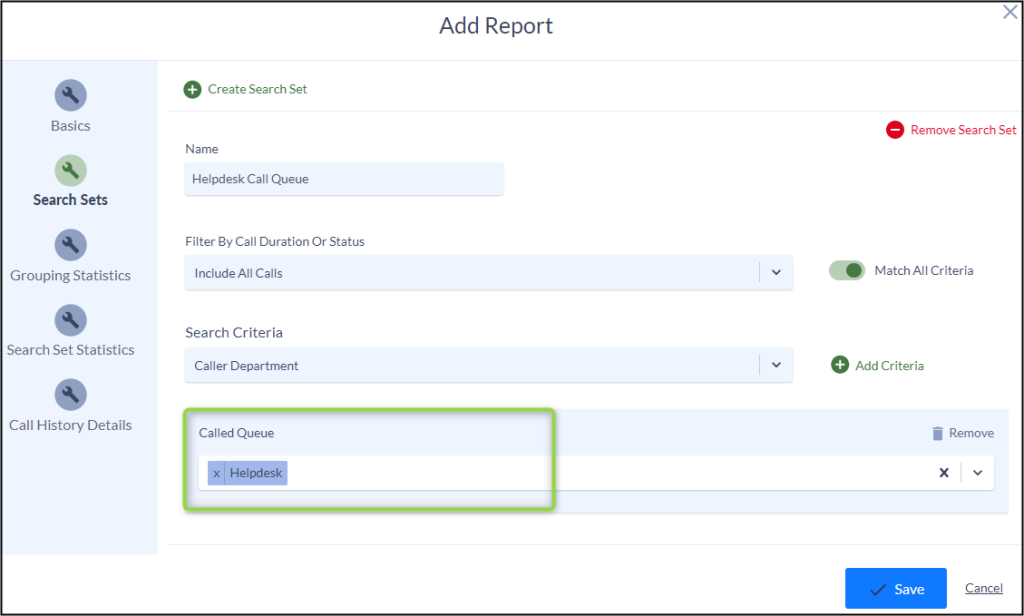
- Originating from users Dan or Abbey
- User based Search sets such as Caller/Called User or Caller/Called Department allow for querying of historic user information. Toggling on the “Show Historical Options” allows you to search on user based information no long existing in your Zoom hierarchy. For example: If a user is no longer with the company but you wish to search his name explicitly, you can toggle on “Show Historical Options” and select the user from the picklist. Historical entities will appear with a small flag next to their respective criteria indicating it is a historical entity.
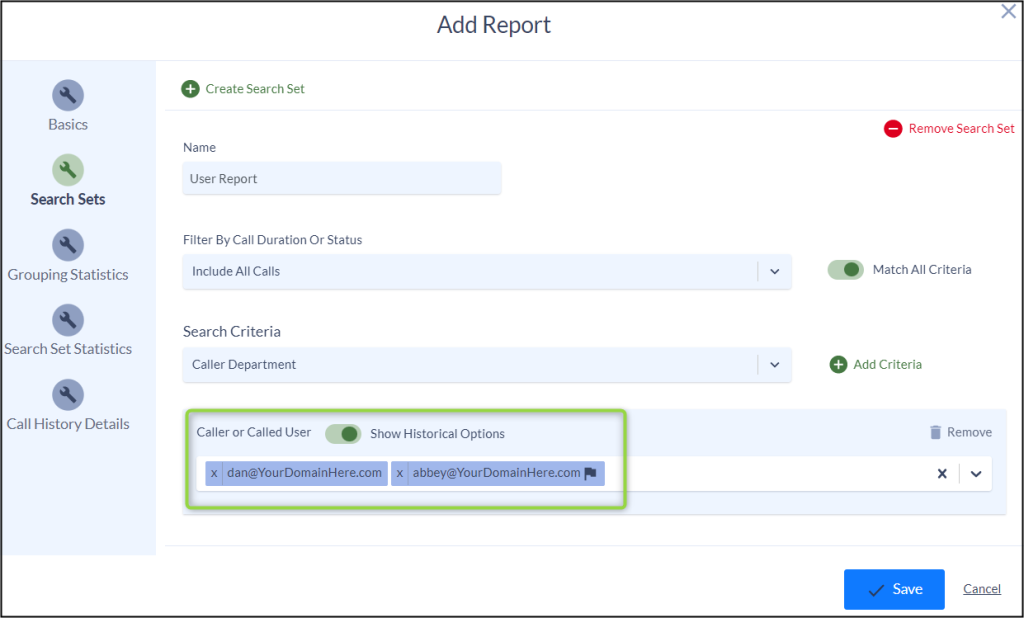
Search Set Statistics
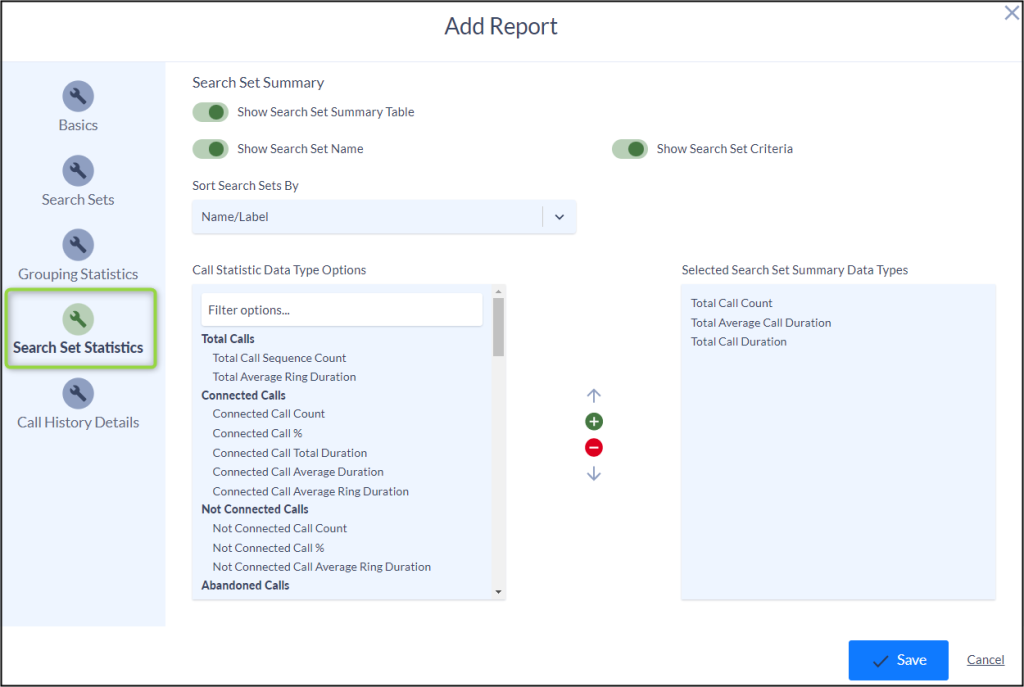
The Search Criteria Summary section will display 1 or more selected statistics per Search Set/Criteria as well as total cumulative values (if the report contains multiple Search Sets).
To enable or disable the Search Criteria Summary, toggle the Show Search Set Summary Table option within the Search Set Statistics tab.
If the Search Criteria Summary is shown, enable or disable the Search Set’s Name or Criteria from appearing by toggling the Show Search Set Name and Show Search Set Criteria options respectively.

Call Statistic Data Type Options
For each Search Set/Criteria, Variphy’s Call Analytics Reporting offers an extensive set of Call Statistic options to choose from, such as:
- Total Call Count
- Total Average Call Duration
- Total Call Duration
- Not Connected Call Count
- Forwarded Call Total Duration
- Answered Call %
- Transferred From Call Count
- For more info on all of the Call Statistic options, read the Variphy Zoom Reporting Data Types & Statistics Guide.
In the below configuration we chose to show Total Call Count, Total Average Call Duration & Total Call Duration data types by moving them from the left to the right.

The output of the select data types chosen above would appear as follows:

Call Statistics and Scenarios
The Call Statistics and Scenarios section provides additional summary layers into your report. Allowing you to add Period over Period Tables, In -Depth Analytics & Period over Period charts.

Total Call Statistic Data Tables

This represents an analytical breakdown of key statistics, computed for each desired Time Unit Type (e.g. Hour Day vs Day of Week).
The following example report output shows 3 Call Statistics (Total Call Count, Answered Call %, and Voice Mail Call %) for the Time Unit Type of Hour of Day as well as Day Of Week, which was based on a specific set of 141,872 calls – resulting from its Search Set Criteria.
- 95.16% of 15,199 Total Calls were Answered between 12:00:00 PM and 12:59:59 PM PDT
- 0 Calls took place between 7:00:00 PM and 7:59:59 PM PDT as well as 9:00:00 PM and 11:59:59 PM PDT
- An Hourly high of 0.07% of 15,199 Total Calls were Voice Mail Calls between 12:00:00 PM and 12:59:59 PM PDT
- A Day of Week high of 32,613 Total Calls took place on Friday as compared to other days of the week
Total Call Scenario Volume Tables

This represents an analytical “summary” of the call volume for each of the selected Call Scenario Types, computed for each desired Time Unit Type (e.g. Hour Day vs Day of Week, producing tables showing metrics such as the low, high, and average call count/volume per Call Scenario, computed for each Time Unit Type.
The following example report output shows 3 Call Scenarios (Total Calls, Answered Calls, and Voice Mail Calls) for the Time Unit Type of Hour of Day as well as Day Of Week, which was based on a specific set of 141,872 calls – resulting from its Search Set Criteria.
- 95.06% (134,861 of the 141,872 Total Calls) were Answered
- 0.04% (60 of the 141,872 Total Calls) went to and were connected to Voice Mail
- Per Hour of the Day, the average # of calls was 5,911.33 with 57.96% Answered and 0.02% going to Voice Mail
- The Low # of Total Calls per Hour was 0 and High was 19,543
Total Call Scenario Volume Charts

Similar to the Total Call Scenario Volume Tables, this represents an analytical “summary” of the call volume for each of the selected Call Scenario Types, computed for each desired Time Unit Type (e.g. Hour Day vs Day of Week), but in vertical bar chart format.
The following example report output shows 5 Call Scenarios (Total Calls, Answered Calls, Abandon Calls, Voice Mail Calls and Queued Calls) for the Time Unit Type of Hour of Day and Day of Week which was based on a specific set of calls – resulting from its Search Set Criteria.
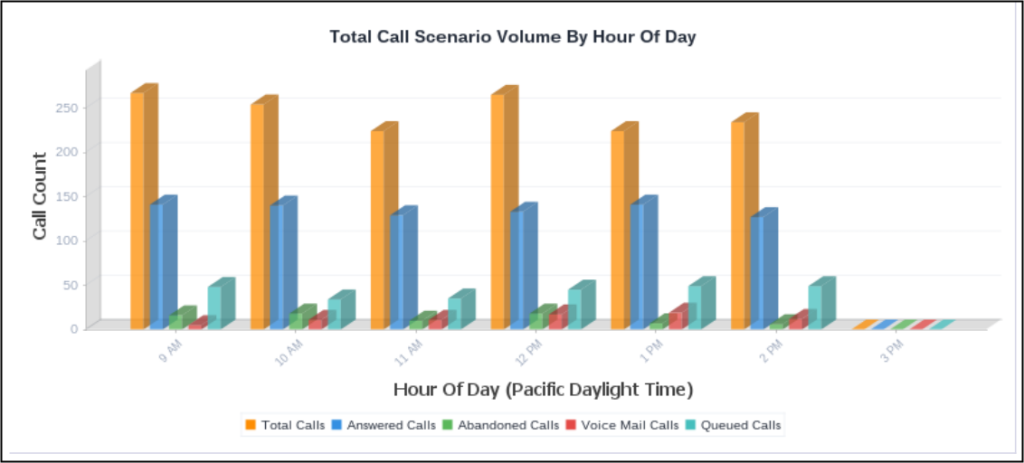

Concurrent Call Activity

Variphy can compute the Concurrent Call Activity, meaning the number of concurrent calls taking place, for each second in time (within the Search Time Window used when generating a report) for the calls identified by the report’s Search Set Criteria. This flexible approach ensures reports can measure and show Concurrent Call Activity for any set of calls whether company/cluster wide or a very granular data set, such as calls to a helpdesk or series of Users.
Concurrent Call Activity Chart
This content option illustrates the Concurrent Call Activity per date (June 10, 2018 vs June 11, 2018, etc) per time of day. As the following example output shows, the peak # of concurrent calls was 15, just after 2:00 PM PDT on June 12, 2018.
Each date will be charted with a different color (green in this example for June 12, 2018).
Because showing too many colors/lines on the same chart can make it difficult to read, Concurrent Call Activity Charts will show a maximum of 7 days per chart. When the Search Time Window includes more than 7 days, multiple charts will be used.
Concurrent Call Activity Summary
The summary provides a brief summary of the Concurrent Call Activity, showing:
- the peak number of concurrent calls (15)
- the number of seconds in which the peak number of concurrent calls took place (5 seconds)
- the average number of concurrent calls over the entire Search Time Window (Previous Week in this example)
Concurrent Call Activity Table
The Concurrent Call Activity Table reveals the total time duration and percentage of time (for the Search Time Window – “Previous Week” in this example) for which the specific number of concurrent calls were taking place. The example output below shows that there were 15 concurrent calls for a total of 5 seconds (00:00:05). The Time Window Percentage column on the right shows the 5 secs is ~ 0.0% of the total Search Time Window (Previous Week).
The example output above can be produced with the following configuration in the “Concurrent Call Activity” section towards the bottom of the “Call Analytics” tab:
Analytics Call Scenario Settings
Call Scenario settings can be configured for the specific report to identify what constitutes and “Long” vs “Short” Duration call. Default values are 3600 seconds (1 hour) for “Long” and 10 seconds for “Short” Duration calls, respectively.
Using the values as shown below, any Connected call which lasts for at least 3600 seconds will be considered a Long Duration call while any those which only lasted for 10 seconds or less are considered a Short Duration call.

Grouping Statistics Summary & Analytics
Groupings are a very powerful and important concept and feature in Variphy’s Call Analytics Reporting. When analyzing and reporting/displaying on a set of call activity, it’s often very helpful to organize or “group” data into groupings such as per Caller/Called User, Caller/Called Number, Department, Called Queue, Location or one of many other options.
Grouping Type
To enable Groupings, toggle the Data Grouping Enabled field to on (green) in the Grouping Statistics tab.
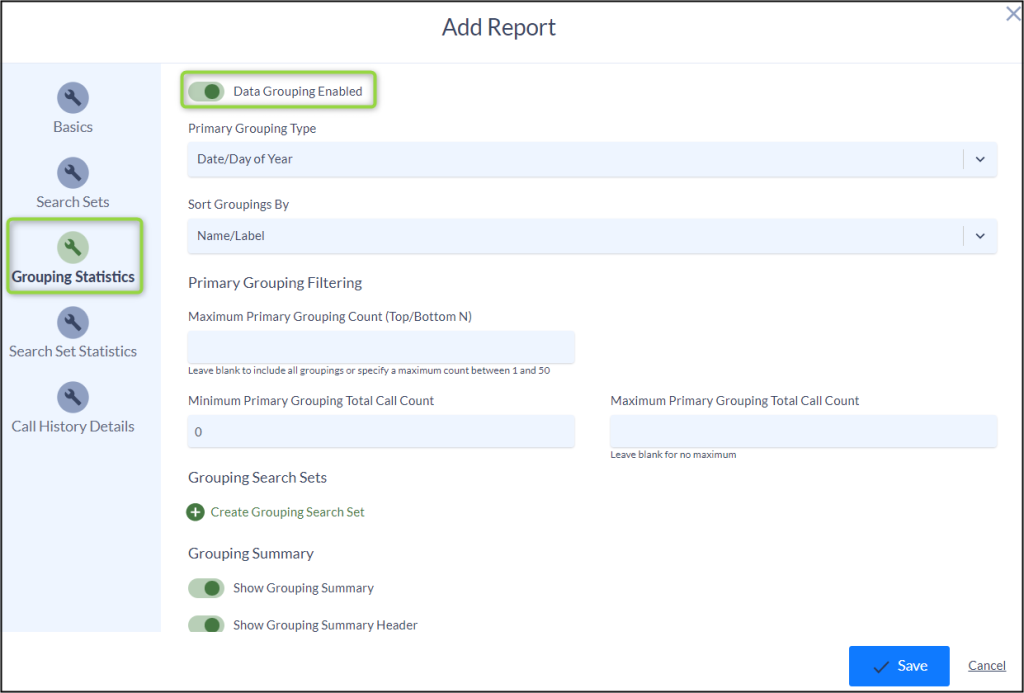
Then, in the Primary Grouping Type field, select the desired Grouping Type. There are many grouping options, many of which are directional, such as Caller User or Called User, Caller Department or Called Department, which will identify which Users or Departments were involved in each call (per the search set/criteria results), based upon the originating Caller User (user who placed the call), and Called User (he/she who ultimately received/answered the call).
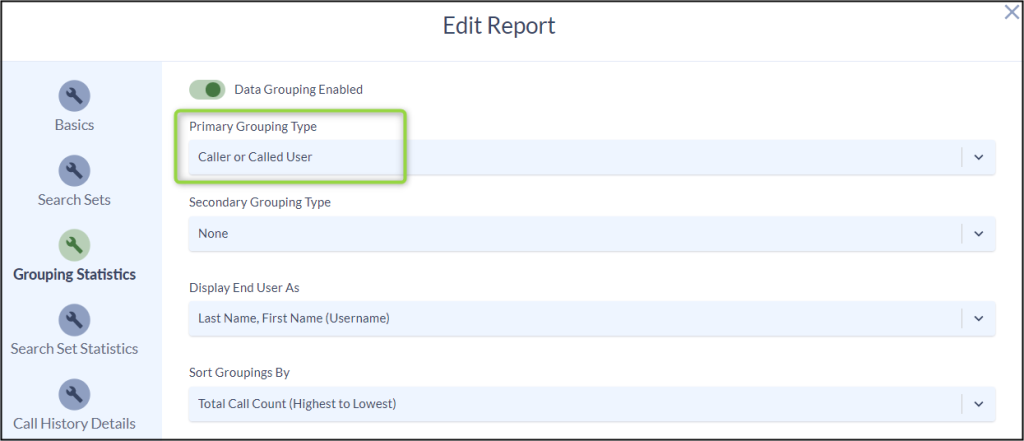
When certain Primary Grouping Types are selected you will be presented with an option for a Secondary Grouping Type. Secondary Groupings is not required but allows reports to summarize on both the Primary grouping then a second set of criteria.
For example: you may group on Caller or Called User and then group secondarily on the types of devices those users utilized. This would provide summary not only on the Caller or Called Users but also the types of devices that were used by each user.
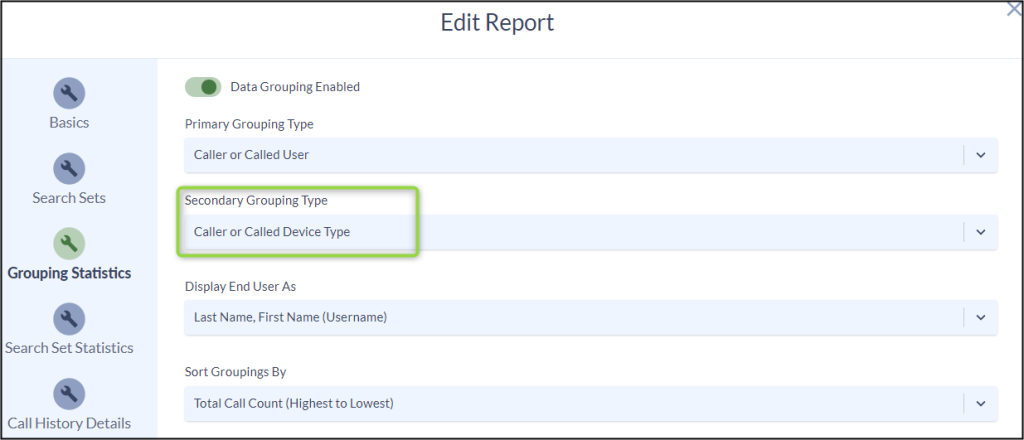
If a User Grouping Type is selected the Display End User As field will provide options for how each End User should be displayed, such as “Last Name, First Name (Username)” or “First Name Last Name”.
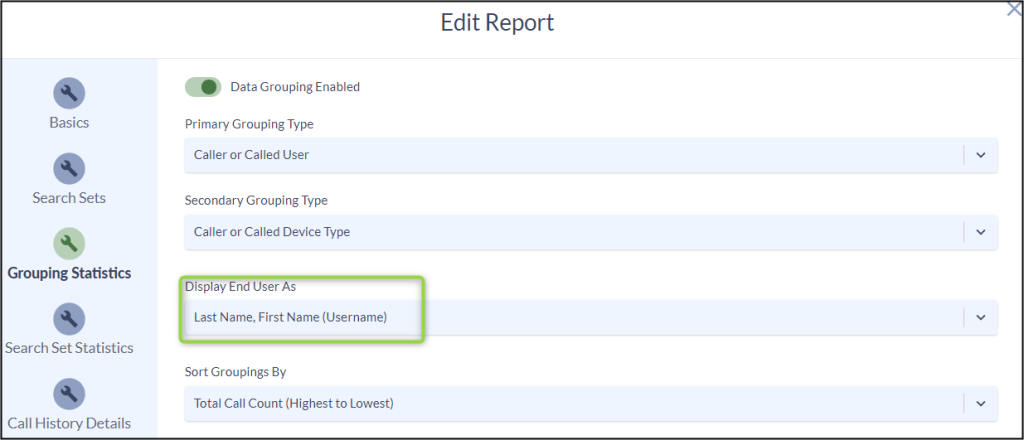
The Sort Groupings By field controls how Groupings should be sorted, such as by Name/Label or Total Call Count (Highest to Lowest).
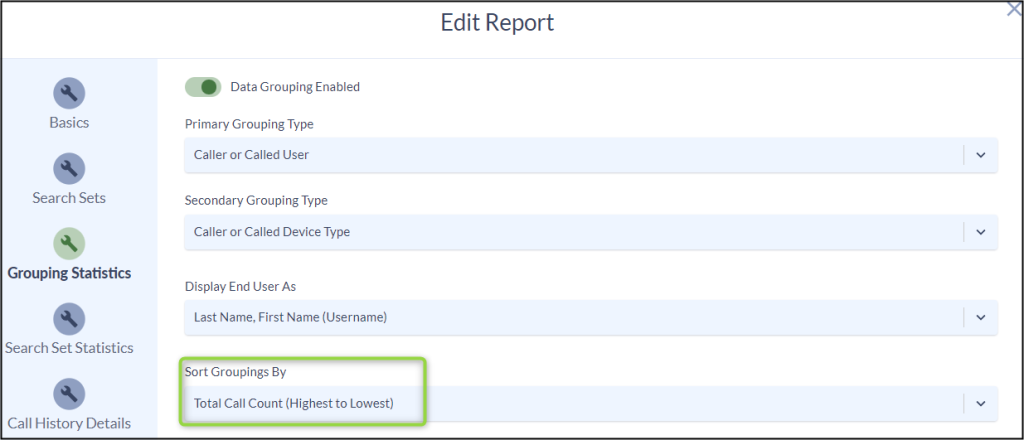
Grouping Filtering
In the Grouping Filtering section there are additional options (all of which are optional) to filter out Groupings based upon the Total Call Count.
If specified between 1 and 50, the Maximum Primary Grouping Count (Top/Bottom N) field will ensure that only the 1st N Groupings will appear, according to the Sort Groupings By field.
If specified, the Minimum Primary Total Call Count and Maximum Total Call Count fields can also provide filtering to only include Groupings where a certain Total Call Count (or range) is met, such as where the Grouping was involved in 1000 calls or more or 0.

Grouping Summary

For example, the output below shows a Grouping Summary for call history that is grouped by Caller or Called User, and statistics for each. Variphy offers a multitude of Grouping options.

The Grouping Summary section will display 1 or more selected statistics per Grouping as well as total cumulative values (if the report contains multiple Groupings).
Show Grouping Summary is enabled by default within the Grouping Statistics tab. Grouping Summary allowing you to select the desired statistics to show per Grouping, such as:
- Total Call Count
- Originating Call Count
- Terminating Call Count
- Abandoned Call Count
- Voice Mail Call Count
- For more info on all of the Call Statistic options, read the Variphy Zoom Reporting Data Types & Statistics Guide.
If the Grouping Summary is enabled, the Show Grouping Summary Header field controls whether a simple section header with text showing the Grouping Type appears above the Grouping Summary table.
Grouping Statistics & Scenarios
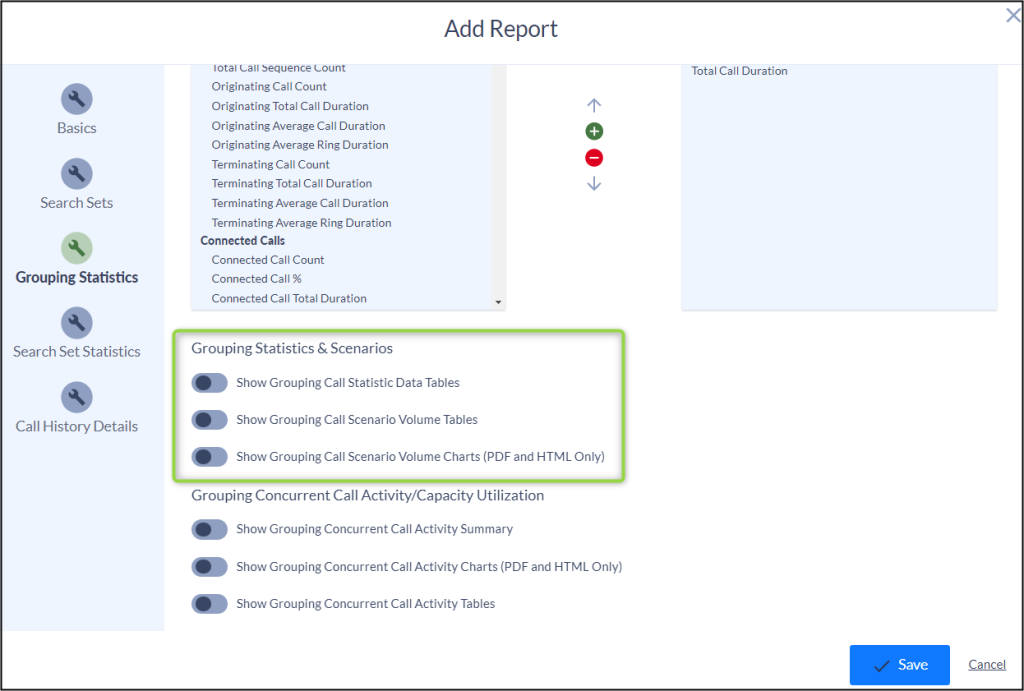
In addition to the Grouping Statistics Summary above, Variphy can also include time period based analytics for each grouping in reports, such as:
- Total call count per Quarter Hour (9:00am – 9:15am, 9:15am – 9:30am, etc)
- Total call count per Half Hour (9:00am – 9:30am, 9:30am – 10am, etc)
- Total call count per Hour (9am, 10am, etc.)
- Total call count per Day of Week (Monday, Tuesday, etc)
- Total call count per Date Of Year (e.g. Feb 10 vs Feb 11, etc)
The Grouping Statistics & Scenarios section in the Grouping Statistics tab contains statistic options for time-based tables and charts that can be computed per Grouping (e.g. per Device Type, User, Department, Number, etc.).
Show Primary Grouping Call Statistic Data Tables

This represents an analytical breakdown of chosen statistics, computed for each desired Time Unit Type (e.g. Hour Day vs Day of Week).
Read more about call statistics in the Variphy Zoom Reporting Data Types & Statistics Guide.
For a Grouping Type of Caller or Called User, the above configuration would show the following output for Primary Grouping Call Statistic Data Tables, showing the Total Call Count for each party number grouping per Hour of Day.
In this example, the report was run for 9:00am to 3:59pm only.

Show Primary Grouping Call Scenario Volume Tables

This represents an analytical “summary” of the call volume for each Grouping, computed for each the selected Call Scenario Types and desired Time Unit Type (e.g. Hour Day vs Day of Week), producing tables showing metrics such as the low, high, and average call count/volume per Call Scenario.
Variphy offers many Call Scenarios to choose from. Read more about call scenarios in the Variphy Zoom Reporting Data Types & Statistics Guide.
For the above configuration, the following example report output shows 3 Call Scenarios (Total Calls, Abandoned Calls, Voice Mail Calls) per Hour of Day for each user (Caller or Called User Grouping).
For Bruce Wayne, this example Call Scenario Volume Table shows:
- A total of 83 calls were made and received by this User.
- Between the hours of 9am to 4pm (which the report was run for), the average per hour was 3.46 calls
- Per Hour of the Day, the average abandoned call rate was 2.86%
- Overall (across all 83 total calls), 14.46% went to Voice Mail.

Show Primary Grouping Call Scenario Volume Charts (PDF Only)
This represents a visual summary of the call volume for each Grouping, computed for each the selected Call Scenario Types and desired Time Unit Type (e.g. Hour Day vs Day of Week), producing Bar charts summarizing on each of the Call Scenario’s selected.

For the above configuration, the following example shows 3 Call Scenarios (Total Calls, Abandoned Calls & Voice Mail Calls) per Hour of Day for the OPERATOR. Each user (Caller or Called User Grouping) will have it’s own graphical representation of call scenario.

Call History Details

If enabled, the Search Result Details section will contain Call Detail data for the original Search Results, in a tabular format.
To enable or disable, toggle the Show Call History Record Details option with the Call History Details tab.
If enabled, select at least 1 or multiple options from a variety of History Detail Columns, including:
- Date/Time Origination
- Ring Time
- Caller Number
- Caller Party Name
- Called Number
- Called Party Name
- Called Device Type
- Direction
- Call Duration

Toggle the Show Call History Record Details Header option to enable or disable the “Call Details” section header in the report.

The example output above can be produced with the following configuration in the Call History Details tab:
